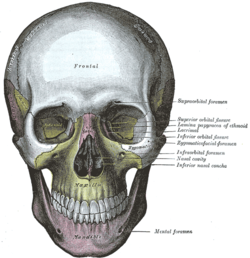Loading AI tools
Opening in the maxillary bone of the skull From Wikipedia, the free encyclopedia
In human anatomy, the infraorbital foramen is one of two small holes in the skull's upper jawbone (maxillary bone), located below the eye socket and to the left and right of the nose. Both holes are used for blood vessels and nerves. In anatomical terms, it is located below the infraorbital margin of the orbit. It transmits the infraorbital artery and vein, and the infraorbital nerve, a branch of the maxillary nerve. It is typically 6.10 to 10.9 mm (0.240 to 0.429 in) from the infraorbital margin.[1]
| Infraorbital foramen | |
|---|---|
 The skull from the front. (Infraorbital foramen labeled at center right, under the eye.) | |
 Articulation of nasal and lacrimal bones with maxilla. (Infraorbital foramen labeled at left.) | |
| Details | |
| Identifiers | |
| Latin | foramen infraorbitale |
| TA98 | A02.1.12.008 |
| TA2 | 763 |
| FMA | 57718 |
| Anatomical terms of bone | |
Forming the exterior end of the infraorbital canal, the infraorbital foramen communicates with the infraorbital groove, the canal's opening on the interior side.
The ramifications of the three principal branches of the trigeminal nerve—at the supraorbital, infraorbital, and mental foramen—are distributed on a vertical line (in anterior view) passing through the middle of the pupil. The infraorbital foramen is used as a pressure point to test the sensitivity of the infraorbital nerve.[2] Palpation of the infraorbital foramen during an extraoral examination or an administration of a local anesthetic agent will cause soreness to the area.[3]
Seamless Wikipedia browsing. On steroids.
Every time you click a link to Wikipedia, Wiktionary or Wikiquote in your browser's search results, it will show the modern Wikiwand interface.
Wikiwand extension is a five stars, simple, with minimum permission required to keep your browsing private, safe and transparent.